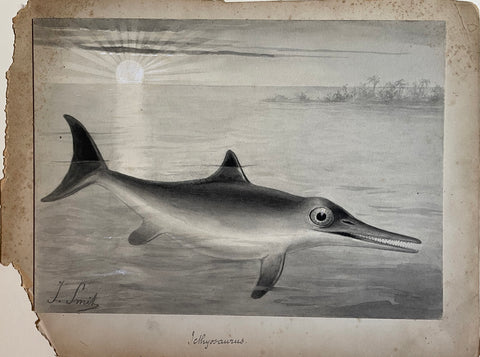
Joseph Smit (1836-1929), A Triassic Icthyosaur
Joseph Smit (1836-1929)
A Triassic Icthyosaur
Original Illustration in pen, ink and grey wash, heightened in white.
c. 1905-1912.
7 1/8 x 10 5/8 in. sheet
Original artwork for Henry R. Knipe’s Nebula to Man. Illustrated on page 54 A Triassic Icthyosaur/in Jurassica deposits species 40 feet in length have been found.
Ichthyosaurs (Ancient Greek for “fish lizard” – romanized: ichthys, lit. ‘fish’ and romanized: sauros, lit. ‘lizard’) are large extinct marine reptiles. Ichthyosaurs belong to the order known as Ichthyosauria or Ichthyopterygia (‘fish flippers’ – a designation introduced by Sir Richard Owen in 1842, although the term is now used more for the parent clade of the Ichthyosauria).
Ichthyosaurs thrived during much of the Mesozoic era; based on fossil evidence, they first appeared around 250 million years ago (Ma). At least one species survived until about 90 million years ago, into the Late Cretaceous. During the Early Triassic epoch, ichthyosaurs and other ichthyosauromorphs evolved from a group of unidentified land reptiles that returned to the sea, in a development similar to how the mammalian land-dwelling ancestors of modern-day dolphins and whales returned to the sea millions of years later, which they gradually came to resemble in a case of convergent evolution. Ichthyosaurs were particularly abundant in the Late Triassic and Early Jurassic periods until they were replaced as the top aquatic predators by another marine reptilian group, the Plesiosauria, in the later Jurassic and Early Cretaceous. However, previous views of ichthyosaur decline during this period are probably overstated. Ichthyosaurs diversity declined due to environmental volatility caused by climatic upheavals in the early Late Cretaceous, becoming extinct around the Cenomanian-Turonian boundary approximately 90 million years ago.
Science became aware of the existence of ichthyosaurs during the early nineteenth century when the first complete skeletons were found in England. In 1834, the order Ichthyosauria was named.
JOSEPH SMIT (1836-1929)
Josef Smit’s dinosaur drawings are a high point in his fine draughtsmanship and unique in his vision to construct an image based on a written description rather than a physical specimen. Knipe’s preface indicates that Smit also learned much from Charles Knight’s drawings at the Museum of Natural History, New York.
Josef Smit was born and raised in Lisse, in southern Holland. Later, in Leiden, his scientific fidelity came to the Natural History Museum of Leiden director Hermann Schlegel’s attention. He presented the artist with his first commission to paint a series of birds from the Dutch East Indies. Smit’s work for Schlegel earned him a significant commission to prepare hundreds of plates for Philip Sclater’s Exotic Ornithology. Once in London, the artist met other like-minded artist-naturalists and developed a reputation for preparing very realistic drawings. Because of his ability to delineate every detail of a specific bird, he was employed by several scientists to illustrate their reports and publications. His work stood apart from his contemporaries in his addition of thorough backgrounds of leaves, vines, and tree branches. Smit eventually became a key contributor to some of the most important natural history publications of the 19th and early-20th centuries. His work graced the tomes by John Gould, Edward Lear, Archibald Thorburn, Henry Constantine Richter, and J.G. Keulemans. His son, Pierre-Jacques Smit was also a skilled watercolorist.
ORIGINAL WATERCOLORS PREPARED FOR HENRY KNIPE’S
NEBULA TO MAN (1905) & EVOLUTION IN THE PAST (1911-1912)
An exceedingly rare collection of original watercolors prepared for Henry Knipe’s Nebula to Man (1905) and Evolution in the Past (1911-1912) by naturalist-artists Alice Woodward, Josef Smit, and Charles Whymper.
Drawings prepared for Knipe’s Nebula to Man (1905) contributed to one of the most important publications on dinosaurs on the heels of the Great Dinosaur Rush or Bone Wars. The Bone Wars occurred between 1877 and 1892 between Edward Drinker Cope, the Academy of Natural Sciences Philadelphia, and Othniel Charles Marsh, the Peabody Museum of Natural History at Yale. These early paleontologists fought ruthlessly to pursue dinosaur fossils, a quest that resulted in an extraordinary period of discovery and the eventual financial ruin of both scientists. Their findings resulted in unearthing 136 new dinosaur species, ushering in a new paleontological research era.
According to Henry Knipe’s obituary, he worked for the British Museum. It was there that he likely met the artists tapped for this project. Knipe chose each illustrator for their reputation for scientific authenticity—namely, those skilled as bird artists, given the many similarities between bird species and dinosaurs.
We Also Recommend

![Albertus Seba (1665-1736) Tab I [Insects]](http://aradergalleries.com/cdn/shop/products/I_large.jpg?v=1635434052)
![Albertus Seba (1665-1736) Tab II [Insects]](http://aradergalleries.com/cdn/shop/products/II_large.jpg?v=1635434726)
![Albertus Seba (1665-1736) Tab III [Insects]](http://aradergalleries.com/cdn/shop/products/III_large.jpg?v=1635434877)
![Albertus Seba (1665-1736) Tab L [Insects]](http://aradergalleries.com/cdn/shop/products/L_b_large.jpg?v=1635435506)
![Albertus Seba (1665-1736) Tab L [Insects]](http://aradergalleries.com/cdn/shop/products/L_large.jpg?v=1635437893)